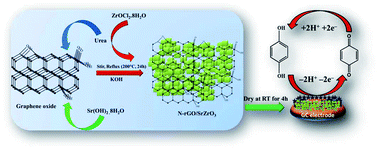A highly sensitive and selective hydroquinone sensor based on a newly designed N-rGO/SrZrO3 composite†
Abstract
Herein, we have reported a novel composite of nitrogen doped reduced graphene oxide (N-rGO) and strontium zirconate (SrZrO3). This new composite (N-rGO/SrZrO3) was synthesized using the reflux method. The physicochemical properties of N-rGO/SrZrO3 were determined using different advanced techniques such XRD, FE-SEM, EDX, FTIR and BET. Furthermore, a glassy carbon electrode was modified with N-rGO/SrZrO3 (GCE-2). This modified electrode was employed for the sensing of HQ. The electrochemically active surface area (ECSA) of this modified electrode (GCE-2) was calculated by employing the Randles–Sevcik equation. Furthermore, GCE-2 exhibited a good detection limit (0.61 μM) including high selectivity towards HQ.



 Please wait while we load your content...
Please wait while we load your content...